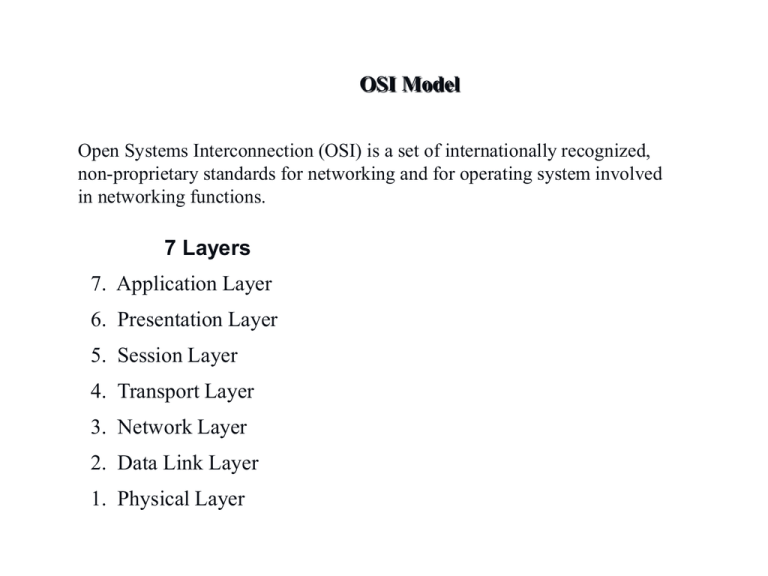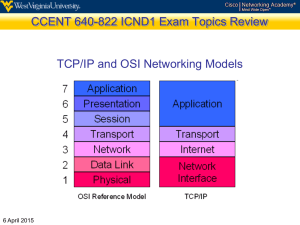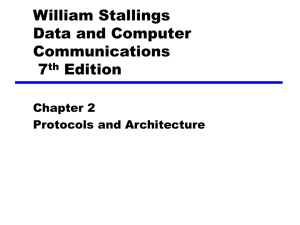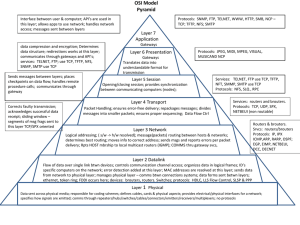OSI
advertisement

OSI Model Open Systems Interconnection (OSI) is a set of internationally recognized, non-proprietary standards for networking and for operating system involved in networking functions. 7 Layers 7. Application Layer 6. Presentation Layer 5. Session Layer 4. Transport Layer 3. Network Layer 2. Data Link Layer 1. Physical Layer LAYER 7 – The APPLICATION Layer • The top layer of the OSI model • Provides a set of interfaces for sending and receiving applications and to use network services, such as: message handling and database query processing • Responsibility: The application layer is responsible for providing services to the user. LAYER 6 – The PRESENTATION Layer • Manages data-format information for networked communications (the network’s translator) • For outgoing messages, it converts data into a generic format for network transmission; for incoming messages, it converts data from the generic network format to a format that the receiving application can understand • This layer is also responsible for certain protocol conversions, data encryption/decryption, or data compression/decompression • A special software facility called a “redirector” operates at this layer to determine if a request is network related on not and forward network-related requests to an appropriate network resource LAYER 5 – The SESSION Layer • Enables two networked resources to hold ongoing communications (called a session) across a network • Applications on either end of the session are able to ex hange data for the duration of the session This layer is: • Responsible for initiating, maintaining and terminating sessions • Responsible for security and access control to session information (via session participant identification) • Responsible for synchronization services, and for checkpoint services LAYER 4 – The TRANSPORT Layer • Manages the transmission of data across a network • Manages the flow of data between parties by segmenting long data streams into smaller data chunks (based on allowed “packet” size for a given transmission medium) • Reassembles chunks into their original sequence at the receiving end • Provides acknowledgements of successful transmissions and requests resends for packets which arrive with errors • The transport layer is responsible for the delivery of a message from one process to another. LAYER 3 – The NETWORK Layer • Handles addressing messages for delivery, as well as translating logical network addresses and names into their physical counterparts • Responsible for deciding how to route transmissions between computers • This layer also handles the decisions needed to get data from one point to the next point along a network path • This layer also handles packet switching and network congestion control LAYER 2 – The DATA LINK Layer • Handles special data frames (packets) between the Network layer and the Physical layer • At the receiving end, this layer packages raw data from the physical layer into data frames for delivery to the Network layer • At the sending end this layer handles conversion of data into raw formats that can be handled by the Physical Layer LAYER 1 – The PHYSICAL Layer • Converts bits into electronic signals for outgoing messages • Converts electronic signals into bits for incoming messages • This layer manages the interface between the the computer and the network medium (coax, twisted pair, etc.) • This layer tells the driver software for the MAU (media attachment unit, ex. network interface cards (NICs, modems, etc.)) what needs to be sent across the medium • The bottom layer of the OSI model • The physical layer is responsible for movements of • individual bits from one hop (node) to the next. Summary What is TCP/IP? • TCP/IP is a set of protocols developed to allow cooperating computers to share resources across a network • TCP stands for “Transmission Control Protocol” • IP stands for “Internet Protocol” • They are Transport layer and Network layer protocols respectively of the protocol suite • The most well known network that adopted TCP/IP is Internet – the biggest WAN in the world 10 What is a protocol? • A protocol is a collection of rules and procedures for two computers to exchange information • Protocol also defines the format of data that is being exchanged 11 Why TCP/IP is so popular? • TCP/IP was developed very early • Technologies were widely discussed and circulated in documents called “Request for Comments” (RFC) – free of charge • Supported by UNIX operating system 12 TCP/IP Model • Because TCP/IP was developed earlier than the OSI 7layer mode, it does not have 7 layers but only 4 layers TCP/IP Protocol Suite FTP, SMTP, Telnet, HTTP,… TCP, UDP IP, ARP, ICMP Network Interface 13 Layer of Models TCP/IP 4-layers OSI 7-layers Application Transport Network Network Interface 14 Layer-1 Application Layer • Application layer protocols define the rules when implementing specific network applications • Rely on the underlying layers to provide accurate and efficient data delivery • Typical protocols: • FTP – File Transfer Protocol • For file transfer • Telnet – Remote terminal protocol • For remote login on any other computer on the network • SMTP – Simple Mail Transfer Protocol • For mail transfer • HTTP – Hypertext Transfer Protocol • For Web browsing 15 Layer-2 Transport Layer Message Application Segments Transport h M h M h M Network Network Interface 16 TCP and UDP TCP – Transmission Control Protocol • TCP is a connection-oriented protocol • Does not mean it has a physical connection between sender and receiver • TCP provides the function to allow a connection virtually exists – also called virtual circuit • TCP provides the functions: • Dividing a chunk of data into segments • Reassembly segments into the original chunk • Provide further the functions such as reordering and data resend • Offering a reliable byte-stream delivery service 17 Layer-3 Network Layer Message Application Segments Transport Network Network Interface h M h h M h M h h M h M h h M Datagrams / Packets 18 Network Addresses and Subnets • A header is added to each segment in the Network layer Total Length 3 Segment IP Time to Live Protocol Header CheckSum Source Address Destination Address Segment 19 Layer-4 Data Link and Physical Layers Message Application Segments Transport Network h M h h M h M h M h h M h h M Packets Network Interface h h h M h h h M Frames 20 Concept • OSI: Open Systems Interconnection. It was developed by ISO as a first step toward international standardization of the protocol used in various layers. It deals with connecting open system.. • TCP/IP: Transport Control Protocol/Internet Protocol. TCP is used in connection with IP and operates at the transport layer. IP is the set of convention used to pass packets from one host to another. Difference • OSI makes the distinction between services, interfaces, and protocol. • The OSI model was devised before the protocols were invented. It can be made to work in diverse heterogeneous networks. • TCP/IP does not originally clearly distinguish between services, interface, and protocol. • TCP/IP model was just a description of the existing protocols. The model and the protocol fit perfectly. Difference (continue) • The OSI model supports both connectionless and connection-oriented communication in the network layer, but only connectionoriented communication in the transport layer. • The TCP/IP model has only one mode in the network layer (connectionless) but supports both modes in the transport layer, giving the user choice. Difference (continue) • OSI emphasis on providing a reliable data transfer service, Each layer of the OSI model detects and handles errors, all data transmitted includes checksums. The transport layer checks sourcedestination reliability. • TCP/IP treats reliability as an end to end Problem. The transport layer handles all error detection and recovery, it was checksums, acknowledgments, and timeouts to control transmissions and provides end-to- Difference (continue) • Host on OSI implementations do not handle network operations. • TCP/IP hosts participate in most network protocols.










